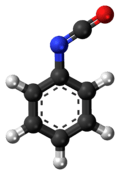Phenylisocyanate
 | |
 | |
| Names | |
|---|---|
| Preferred IUPAC name
Isocyanatobenzene | |
| Identifiers | |
| 103-71-9 | |
| 3D model (Jmol) | Interactive image |
| ChEBI | CHEBI:53806 |
| ChemSpider | 7389 |
| ECHA InfoCard | 100.002.852 |
| PubChem | 7672 |
| UNII | 196GO6BSOH |
| |
| |
| Properties | |
| C7H5NO | |
| Molar mass | 119.12 g·mol−1 |
| Appearance | Colourless liquid |
| Density | 1.09 |
| Melting point | -30 °C |
| Boiling point | 165 °C |
| Reacts with water | |
| Except where otherwise noted, data are given for materials in their standard state (at 25 °C [77 °F], 100 kPa). | |
| | |
| Infobox references | |
Phenylisocyanate is an organic compound typically abbreviated PhNCO. The molecule consists of a phenyl ring attached to the isocyanate functional group. It is a colourless liquid that reacts with water. Phenylisocyanate has a strong odor and tearing vapours, therefore it should be handled in the fumehood.
Characteristic of other isocyanates, it reacts with amines to give ureas.[1] Similarly, reacts with alcohols to form carbamates.
It is used in addition with triethylamine to activate nitro groups to undergo (C,O) 1,3-dipolar cycloaddition (as opposed to O,O). The nitro group (RCH2NO2) is converted to RCNO in the reaction, with CO2 as one of the by products.[2]
Uses
- One example of the use of PhNCO is in the synthesis of prinomide.
- Another use is in the synthesis of Mesocarb.
References
- ↑ Emmanuil I. Troyansky "Phenyl Isocyanate" in Encyclopedia of Reagents for Organic Synthesis, 2001 John Wiley & Sons doi:10.1002/047084289X.rp073
- ↑ Mukaiyama, Teruaki; Hoshino, Toshio (1960). "The Reactions of Primary Nitroparaffins with Isocyanates". Journal of the American Chemical Society. 82: 5339. doi:10.1021/ja01505a017.
External links
This article is issued from Wikipedia - version of the 11/8/2016. The text is available under the Creative Commons Attribution/Share Alike but additional terms may apply for the media files.